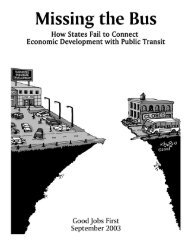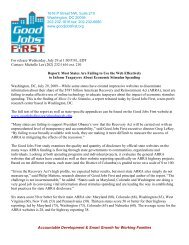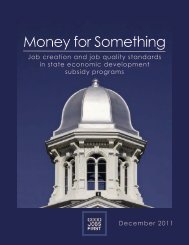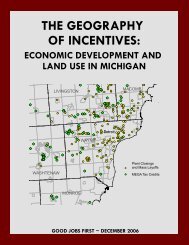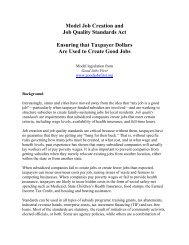Subsidizing the Low Road: Economic ... - Good Jobs First
Subsidizing the Low Road: Economic ... - Good Jobs First
Subsidizing the Low Road: Economic ... - Good Jobs First
You also want an ePaper? Increase the reach of your titles
YUMPU automatically turns print PDFs into web optimized ePapers that Google loves.
6. Case Study: The Baltimore Waterfront MarriottThe first payment-in-lieu-of-taxes (PILOT) agreement negotiated between <strong>the</strong>city and a private company generated a great deal of controversy, including a lawsuit, astate legislative fight, and <strong>the</strong> rewriting of <strong>the</strong> PILOT legislation.In 1999, <strong>the</strong> city entered into a PILOT with local developer John Paterakis toconstruct a 750-room Marriott hotel on <strong>the</strong> east side of <strong>the</strong> Inner Harbor. According to<strong>the</strong> city's own estimates, <strong>the</strong> PILOT will cost <strong>the</strong> city $2.3 million in lost property taxrevenue in 2002 and more than $30 million over <strong>the</strong> 25-year duration of <strong>the</strong>agreement. 134The hotel deal originated in 1996, soon after <strong>the</strong> Maryland Stadium Authorityhad completed its $150 million expansion of <strong>the</strong> Baltimore City Convention Center.The city and state had originally undertaken <strong>the</strong> project to help Baltimore competeagainst Philadelphia and Washington, DC for large conventions. Convention centerboosters argued that <strong>the</strong> project would result in $340 million in convention-relatedspending each year that would generate more than $30 million in state and localrevenue. 135 However, once <strong>the</strong> project was completed, convention center bookings fellfar short of <strong>the</strong> projections originally used to justify <strong>the</strong> expansion. Ra<strong>the</strong>r thanreexamining <strong>the</strong> assumptions behind <strong>the</strong> original projections, Baltimore officialsdecided that <strong>the</strong> convention center was losing business because <strong>the</strong> city did not haveenough hotel rooms to handle large events.In 1996, <strong>the</strong> city asked <strong>the</strong> Legg Mason Realty Group to study Baltimore's hotelmarket. The resulting report concluded that <strong>the</strong> city needed about 1,200 more hotelrooms to satisfy <strong>the</strong> new demands for space created by <strong>the</strong> convention centerexpansion. However, <strong>the</strong> study, which assumed that <strong>the</strong> convention center would befully booked, 136 ignored <strong>the</strong> fact that demand for convention center space wasrelatively flat in <strong>the</strong> 1990s. 137 Creating more hotel rooms would not solve this problem,but plans for <strong>the</strong> Inner Harbor hotel went ahead none<strong>the</strong>less.In 1997, <strong>the</strong> Baltimore Development Corporation asked developers to submitproposals for <strong>the</strong> hotel, promising that public subsidies would be provided. Severalestablished developers entered <strong>the</strong> competition, but <strong>the</strong> BDC awarded <strong>the</strong> project toJohn Paterakis, <strong>the</strong> owner of a local bakery empire. Paterakis proposed to build aWyndham hotel on <strong>the</strong> east side of <strong>the</strong> Inner Harbor. Many observers were surprisedby this decision. The Paterakis site -- which was not even considered in <strong>the</strong> LeggMason study -- was over a mile from <strong>the</strong> convention center, well beyond walkingdistance. 138 Paterakis proposed some unconventional solutions to this probleminvolving aerial cable cars, people movers and water taxis, but many observers31



